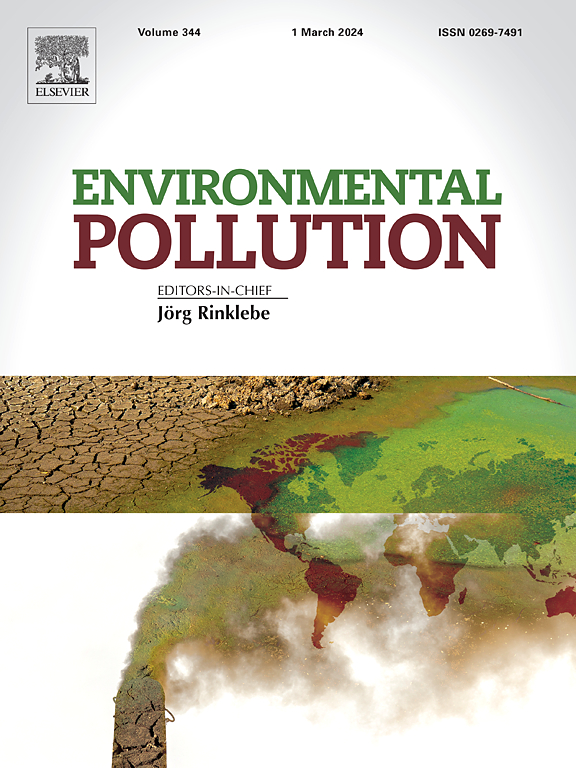Combined effects of extreme cold events and fine particulate matter on the success rate of in vitro fertilization-embryo transfer: A multi-center retrospective cohort study in China
IF 7.6
2区 环境科学与生态学
Q1 ENVIRONMENTAL SCIENCES
引用次数: 0
Abstract
As climate change intensifies, the rising frequency of extreme cold events (ECEs) and the known effects of fine particulate matter (PM2.5) on reproductive health highlight a gap in understanding their combined impact on in vitro fertilization-embryo transfer (IVF-ET) success rate. We conducted a multicenter retrospective cohort study in China to explore the association between ECEs and the risk of clinical pregnancy failure (CPF) undergoing IVF-ET, and the combined effects of ECEs and PM2.5 on CPF risk. The study included a total of 96,623 women undergoing IVF-ET, including 40,798 women undergoing fresh embryo transfers and 55,645 women undergoing frozen embryo transfers, with CPF rates of 48.1 % and 46.6 %, respectively. Our results showed that ECEs exposure were positively associated with CPF risk in women undergoing fresh embryo transfer, with the maximum relative risk (RR) of 1.05 (95 % CI: 1.02, 1.08). Furthermore, combined exposure to ECEs and high concentration of PM2.5 further increased the risk of CPF, with the RR of 1.07 (95 % CI: 1.03, 1.11). However, there was no significant association between ECEs and CPF risk in women undergoing frozen embryo transfer. Similarly, no association was found between the combined exposure to ECEs and high concentration of PM2.5 and the CPF risk. Our study provided novel evidence for the adverse effects of ECEs, and the combined exposure to ECEs and PM2.5 on IVF-ET success rate.

极端寒冷事件和细颗粒物对体外受精-胚胎移植成功率的联合影响:中国一项多中心回顾性队列研究
随着气候变化的加剧,极端寒冷事件(ECEs)频率的上升以及细颗粒物(PM2.5)对生殖健康的已知影响凸显了在理解它们对体外受精-胚胎移植(IVF-ET)成功率的综合影响方面的差距。我们在中国进行了一项多中心回顾性队列研究,探讨了体外受精-体外受精(IVF-ET)中,ECEs与临床妊娠失败(CPF)风险之间的关系,以及ECEs和PM2.5对CPF的联合影响。该研究共纳入96623名接受IVF-ET的女性,其中40798名接受新鲜胚胎移植,55645名接受冷冻胚胎移植,CPF率分别为48.1%和46.6%。我们的研究结果显示,在接受新鲜胚胎移植的妇女中,暴露于ECEs与CPF率呈正相关,最大相对风险为1.05 (95% CI: 1.02, 1.08)。此外,暴露于ECEs和高浓度PM2.5进一步增加了CPF的风险,相对风险为1.07 (95% CI: 1.03, 1.11)。然而,在接受冷冻胚胎移植的妇女中,ECEs和CPF率之间没有显著的关联。同样,没有发现暴露于ECEs和高浓度PM2.5与CPF率之间的关联。我们的研究提供了新的证据,证明了体外受精体外受精(ECEs)的不良影响,以及ECEs和PM2.5联合暴露对IVF-ET成功率的影响。
本文章由计算机程序翻译,如有差异,请以英文原文为准。
求助全文
约1分钟内获得全文
求助全文
来源期刊

Environmental Pollution
环境科学-环境科学
CiteScore
16.00
自引率
6.70%
发文量
2082
审稿时长
2.9 months
期刊介绍:
Environmental Pollution is an international peer-reviewed journal that publishes high-quality research papers and review articles covering all aspects of environmental pollution and its impacts on ecosystems and human health.
Subject areas include, but are not limited to:
• Sources and occurrences of pollutants that are clearly defined and measured in environmental compartments, food and food-related items, and human bodies;
• Interlinks between contaminant exposure and biological, ecological, and human health effects, including those of climate change;
• Contaminants of emerging concerns (including but not limited to antibiotic resistant microorganisms or genes, microplastics/nanoplastics, electronic wastes, light, and noise) and/or their biological, ecological, or human health effects;
• Laboratory and field studies on the remediation/mitigation of environmental pollution via new techniques and with clear links to biological, ecological, or human health effects;
• Modeling of pollution processes, patterns, or trends that is of clear environmental and/or human health interest;
• New techniques that measure and examine environmental occurrences, transport, behavior, and effects of pollutants within the environment or the laboratory, provided that they can be clearly used to address problems within regional or global environmental compartments.
 求助内容:
求助内容: 应助结果提醒方式:
应助结果提醒方式:


